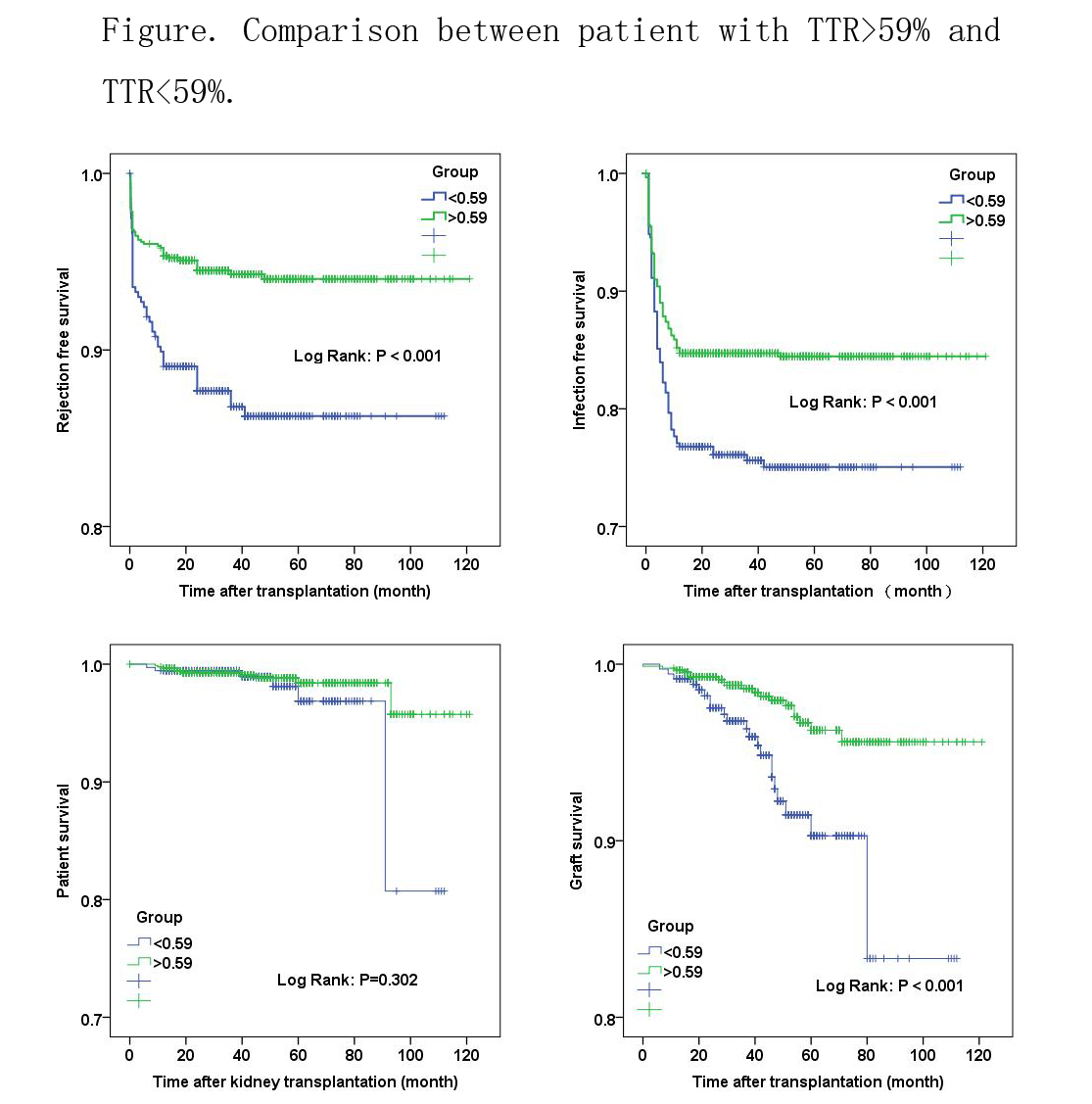Increasing Time-in-Therapeutic Range of Tacrolimus is Associated with Superior Outcomes in Living Kidney Transplants
Organ Transplantation Center, Urology Department, Urology Research Institute, WestChina Hospital, Sichuan University, Chengdu, China
Meeting: 2019 American Transplant Congress
Abstract number: 524
Keywords: FK506, Kidney transplantation, Monitoring
Session Information
Session Name: Concurrent Session: Kidney Immunosuppression: Novel Regimens and Drug Minimization III
Session Type: Concurrent Session
Date: Tuesday, June 4, 2019
Session Time: 4:30pm-6:00pm
 Presentation Time: 4:30pm-4:42pm
Presentation Time: 4:30pm-4:42pm
Location: Veterans Auditorium
*Purpose: Tacrolimus-based regimens remain the backbone of maintenance immunosuppressive therapy in kidney transplant, and therapeutic drug monitoring of tacrolimus is necessary due to a narrow therapeutic window. Time-in-therapeutic range(TTR) is important in the use of narrow therapeutic window medication. We investigated the effects of time-in-therapeutic range(TTR) of tacrolimus on acute rejection, infection control, patient and graft survival.
*Methods: In this retrospective cohort study, we collected clinical data from total 1421 living related kidney transplants from August 2007 to April 2017. All included patients received tacrolimus-based triad regimens and were followed up for at least 1 year. TTR at 1 year was calculated using the target tacrolimus trough level(5-12 ng/ml for the first year), and the optimal cut-off point of TTR were calculated using the receiver operating characteristic(ROC) curve based on acute rejection (AR) rate within the first year. The primary endpoints were the rate of AR and graft loss. The secondary endpoint was the rate of infection and patient survival.
*Results: The optimal cut-off point for TTR was 59%. Total 76 patients developed AR within the first year, accounting for 75.2% of patients developing AR. In the median follow up of 44.5 months, 13.6%(49/361) of patients with TTR<59% developed AR compared with 5.9%(52/880) of patients with TTR>59%(P<0.001). Increasing TTR by 10% was associated with 18% reduced risk of AR (OR=0.818, 95%CI: 0.752-0.890). Multilogistic analysis revealed TTR>59% is associated with significantly lower the risk of AR (OR=0.397, 95%CI: 0.223-0.707). The cumulative incidence of graft loss was 5.8%(21/361) in patients with TTR>59%, as compared with 2.2%(19/880) in patients with TTR<59%. Increasing TTR by 10% was associated with 20% reduced risk of graft loss(OR=0.801, 95%CI: 0.705-0.901). Graft survival at 1, 3, 5 year is 99.7%, 98.2%, 96.3% for patients with TTR>59% compared to 99.2%, 95.9%, 90.3%(P<0.001) for those with TTR<59%. TTR<59% is an independent risk factor for graft loss(OR=2.793, 95%CI: 1.475-5.291). Interesting, infection was more frequent in patients with TTR<59% than those with TTR>59%(86[23.8%] vs. 134[15.2%]; OR=2.994, 95%CI: 1.238-7.246; P<0.001). Increasing TTR by 10% was associated with significantly lower risk of infection(OR=0.888, 95%CI: 0.834-0.946). TTR was not associated with patient survival(OR=0.680, 95%CI: 0.245-1.885). Patient survival at 1, 3, 5 year is 99.7%, 99.0%, 98.4% for those patients with TTR>59% compared to 99.4%, 99.1%, 96.9%(P=0.446) for patients with TTR<59%.
*Conclusions: TTR was inversely associated with the incidence of acute rejection, graft loss and infection. TTR>59% may reduce the risk of AR and infection, and improve graft survival.
To cite this abstract in AMA style:
Lin T, Song T, Yin S, Jiang Y, Huang Z, Wang X, Liu J, Wang Z. Increasing Time-in-Therapeutic Range of Tacrolimus is Associated with Superior Outcomes in Living Kidney Transplants [abstract]. Am J Transplant. 2019; 19 (suppl 3). https://atcmeetingabstracts.com/abstract/increasing-time-in-therapeutic-range-of-tacrolimus-is-associated-with-superior-outcomes-in-living-kidney-transplants/. Accessed December 22, 2025.« Back to 2019 American Transplant Congress

